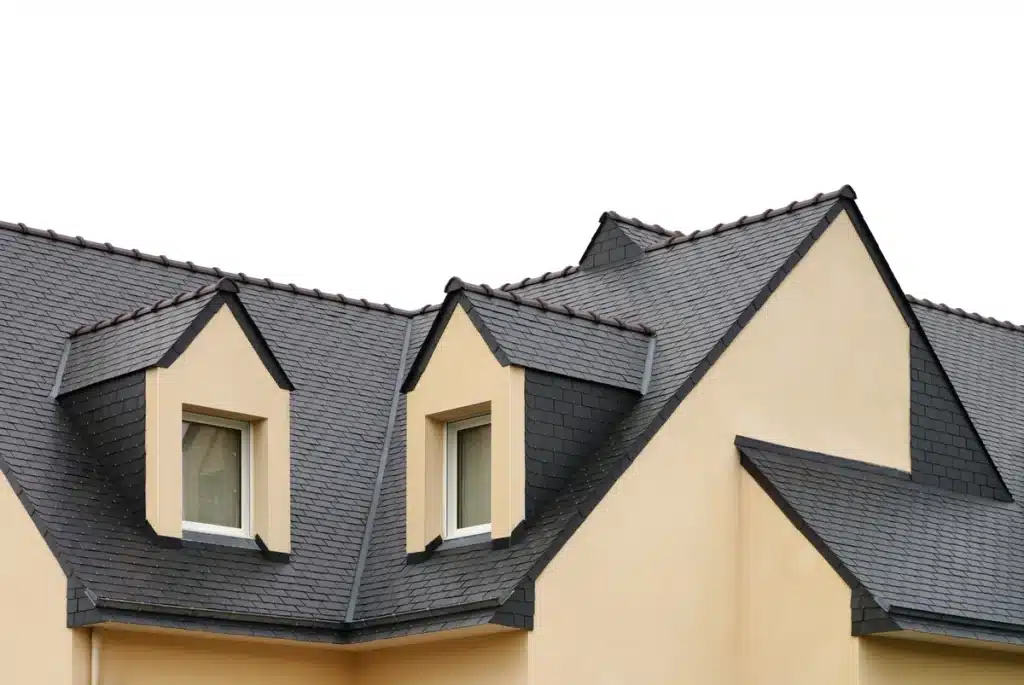How to Replace a Shingle
Table of Contents
Your roof stands as the first line of defense against the elements, shielding you and your family from rain, wind, snow, and sunlight. Yet, over time, even the sturdiest roofs can develop wear and tear, with missing or damaged shingles being a common issue. Learning [How to replace a shingle] can save you money and help you maintain your roof’s integrity.
Ignoring this problem can lead to more significant damage to your roof and home interior. But with this guide, we’ll walk you through:
- The process of identifying missing shingles
- Determining whether they need replacement
- [How to replace a shingle]
- Ensuring your roof’s longevity

Signs that Your Roof is Missing a Shingle
Unless you get up close and personal with your roofing system, it can be tricky to spot a single missing shingle. Here are some tips to help find it:
- Visible Gaps: Take a visual inspection of your roof from ground level. If you notice any gaps or irregularities in the shingle pattern, it’s likely that a shingle is missing.
- Granule Buildup: Check your gutters for an accumulation of granules. Shingles lose granules as they age or become damaged, so finding excessive granules can indicate missing or deteriorating shingles.
- Water Stains on Ceilings: If you notice water stains or leaks in your home’s interior, it could be a sign that water is seeping in through a missing shingle or damaged area on your roof.
- Curling or Buckling Shingles: Shingles that are curling at the edges or appear buckled are more prone to being dislodged by wind or other weather elements.
Determining the Need for Replacement
Once you’ve identified a missing shingle or suspect one is damaged, it’s essential to assess whether it needs replacement. Learning [How to replace a shingle] begins with understanding when replacement is necessary.
- Extent of Damage: Determine the extent of the damage. If the shingle is merely lifted but not torn or significantly damaged, you may be able to reseal it without replacement.
- Age of Shingles: Consider the age of your roof and shingles. If your roof is nearing the end of its lifespan, it’s often more cost-effective to replace the entire roof rather than individual shingles.
- Extent of Exposure: Assess the area where the shingle is missing. If the roof deck is exposed, it leaves your home vulnerable to water damage, mold growth, and structural issues.
The Dangers of Leaving Your Roof Deck Exposed

Leaving your roof deck exposed due to missing shingles can lead to several significant problems:
- Water Damage: Exposure to rain and moisture can seep into your home’s structure, causing water damage to ceilings, walls, and insulation.
- Mold and Mildew: Moisture trapped in the attic or walls can promote the growth of mold and mildew, which poses health risks and requires costly remediation.
- Structural Issues: Over time, prolonged exposure to the elements can weaken the structural integrity of your roof deck, leading to sagging or even collapse in severe cases.
[How to Replace a Shingle]: A 5-Step Guide
If you’ve determined that a shingle needs replacement, follow these steps to do it yourself:
- Gather Materials:
You’ll need replacement shingles, roofing nails, a pry bar, roofing cement, and a caulking gun. - Safety First:
Ensure you have proper safety gear, including gloves, goggles, and sturdy footwear. Work on a dry, sunny day to reduce the risk of slips. - Remove the Damaged Shingle:
Use the pry bar to carefully lift the shingle tabs above the damaged one. Remove any nails or adhesive holding the damaged shingle in place. - Install the Replacement Shingle:
Slide the new shingle into place, ensuring it aligns with the surrounding shingles. Nail it securely and apply roofing cement to seal the edges. - Press and Seal:
Press down on the new shingle to ensure a tight seal with the adhesive. Use the caulking gun to apply additional roofing cement along the edges for extra protection.
Do You Need to Hire a Professional?
While learning [How to replace a shingle] is useful, there are instances where hiring a professional roofer may be more appropriate:
- Extent of Damage: If the damage extends beyond a single shingle or if multiple shingles are missing, it may indicate more significant underlying issues that require professional assessment.
- Safety Concerns: Working at heights can be dangerous, especially for those without proper training or experience. If you’re uncomfortable or unsure about your ability to work safely on the roof, it’s best to leave it to the professionals.
- Warranty Considerations: If your roof is still under warranty, attempting DIY repairs could void the warranty. Hiring a licensed roofer ensures that the repairs are done correctly and maintain the warranty coverage.
Cost to Replace a Single Shingle
The cost of replacing a single shingle depends on various factors. When considering [How to replace a shingle], keep in mind:
- Type of Shingle: Asphalt shingles are generally more affordable than wood or slate shingles.
- Labor Costs: Professional labor adds to the cost, but DIY replacement saves on labor expenses.
- Extent of Damage: Additional materials and labor for extensive damage can increase costs.
- Accessibility: Steep or difficult-to-access roofs may require specialized equipment, raising costs.

How to Avoid Losing Shingles in the Future
Preventative maintenance is key to avoiding future shingle loss:
- Conduct regular inspections.
- Trim overhanging branches to reduce debris.
- Clean gutters and downspouts regularly.
- Invest in quality materials when replacing your roof or shingles.
A Roofing Contractor You Can Trust
Replacing a single shingle may seem like a minor task, but it plays a crucial role in maintaining the integrity of your roof. By knowing [How to replace a shingle], assessing damage, and following proper replacement techniques, you can prolong your roof’s lifespan.
When in doubt, consult with a professional roofer to address any roofing issues safely and effectively. The team at Tectum Roofing is always here to help! Contact us today to get started. [how to replace a shingle]



